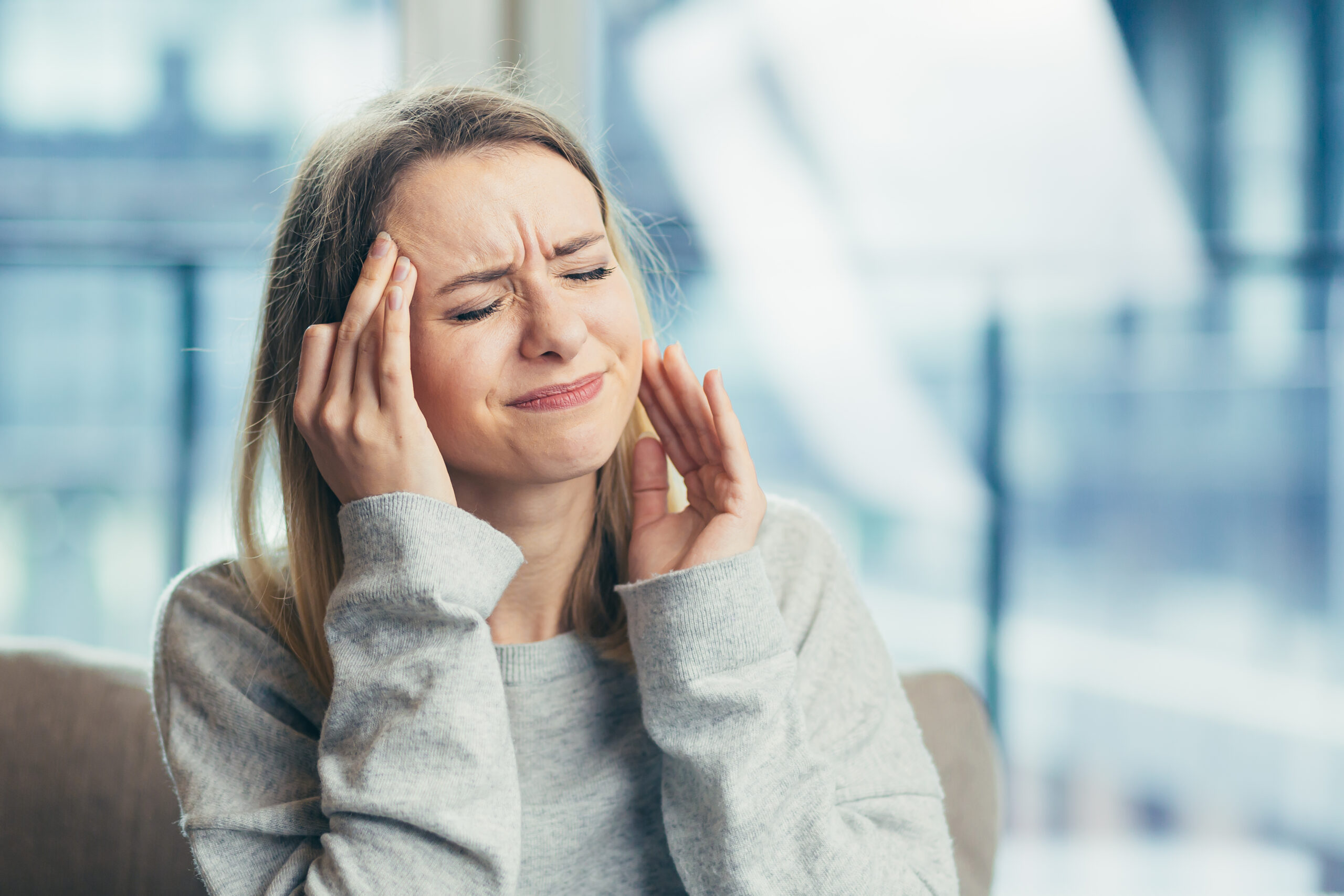If you’ve recently started using Invisalign and noticed a headache creeping in, you’re not alone. Many people wonder if their clear aligners could be the reason behind that nagging pain. It’s normal to feel a little discomfort when something new is happening with your teeth, but when it turns into a headache, it can be frustrating. Let’s talk about why this might happen, and what you can do to feel better.
Can Invisalign Cause Headaches?
If you’ve just started wearing Invisalign and noticed a headache creeping in, you’re not alone. It’s pretty common to feel a bit of discomfort in the beginning. That headache usually comes from your teeth slowly shifting into place, which is exactly what the aligners are designed to do.
Headaches tend to show up during the early stages of treatment. The good news is they’re usually temporary. Most people find that the discomfort fades as their mouth gets used to the aligners.
Curious to learn more about Invisalign and its benefits? Visit our comprehensive information.
Why Are Your New Invisalign Aligners Giving You Headaches?
There are a few reasons this could be happening. For starters, your aligners might be making small changes to your bite. That can lead to some jaw tension or muscle soreness, which sometimes shows up as a headache.
It’s also possible that the stress of wearing aligners for the first time is playing a part. Feeling a little anxious or uncomfortable in the beginning is totally normal and usually settles down on its own.
Another thing to keep in mind is teeth grinding. When you first get your aligners, you might clench your jaw without even noticing it. If you already deal with bruxism or teeth grinding, this can make the headaches worse. In that case, it’s best to talk to your orthodontist before starting treatment with Invisalign.
Why Does Invisalign Cause Headaches?
Invisalign can cause headaches due to the following factors:
| Factor | Description | Potential Link to Headache |
|---|---|---|
| Orthodontic Alignment Process | Gradual movement of teeth to achieve proper alignment using a series of custom-made clear aligners. | The subtle but constant force applied to teeth can transmit to the jaw and surrounding muscles, potentially triggering tension headaches. |
| Jaw Adaptation & Muscle Strain | The jaw muscles work to accommodate the new positions of the teeth as they shift under the pressure of the Invisalign aligners. | This adaptation period can lead to increased tension in the temporomandibular joint (TMJ) and facial muscles, a common cause of tension headaches. |
| Initial Aligner Discomfort | The first few days or weeks of wearing a new set of aligners can cause mild soreness and pressure as the teeth begin to move. | This initial feeling can sometimes result in a mild headache. |
| Individual Physiological Response | Everyone feels things differently. Some people hardly notice Invisalign, while others are more sensitive. | If you tend to get tension headaches easily, you might be more likely to experience them when starting Invisalign treatment. |
Tips to Manage and Ease Invisalign Headaches
-
Try Pain Relievers, But Don’t Ignore Ongoing Pain
If your headache sticks around, a basic pain reliever might help for a while. But if the pain keeps coming back or feels too strong, make sure to speak to your orthodontist. It’s better to catch any potential issues early.
-
Use a Warm Compress for Relief
Place a warm cloth or compress on your forehead or jaw. It helps loosen up tight muscles and can calm down the headache.
-
Keep Yourself Hydrated
Not drinking enough water can lead to headaches. Make sure you sip water regularly throughout the day to avoid dehydration.
-
Practice Simple Relaxation Methods
Stress can trigger headaches, especially when you’re adjusting to Invisalign. Try deep breathing, meditation, or even just sitting quietly for a few minutes to help relax your muscles and mind.
-
Ask About a Mouthguard if You Grind Your Teeth
If you notice any signs of teeth grinding or jaw clenching, speak to your dentist. A custom mouthguard can help ease muscle strain and protect your teeth.
-
Talk to Your Dentist if Pain Doesn’t Go Away
Persistent or intense headaches should not be ignored. Your dentist can assess the cause and recommend adjustments or treatments to ensure your Invisalign journey remains comfortable.
How to Keep Headaches Away During Invisalign Treatment?
- Wear Aligners as Instructed: Stick to the recommended wear schedule to avoid added pressure on your jaw from inconsistent use.
- Avoid Clenching or Grinding: Be mindful of jaw tension. If you catch yourself clenching, try to relax your jaw muscles.
- Use Cold Compresses: Apply a cold pack to your forehead or jaw if you feel a headache coming on.
- Manage Stress: Practice deep breathing or relaxation techniques to reduce tension headaches linked to stress.
- Eat Soft Foods: Especially in the first few days of a new tray, soft foods can ease pressure and reduce the risk of headaches.
- Check for Proper Fit: Poorly fitting aligners can strain your jaw. Report any issues to your orthodontist right away.
- Take OTC Pain Relief if Needed: Use mild painkillers like paracetamol if approved by your doctor or dentist.
- Practice Good Posture: Slouching can add strain to your neck and jaw, which can lead to headaches.
- Follow Up Regularly: Attend all orthodontic appointments so your treatment can be adjusted before problems worsen.
Is Your Headache From Invisalign or Something Else?
It’s common to get a mild headache when you start Invisalign, but it’s important to notice how often it happens and how bad it feels. If your teeth are very misaligned or your bite is off, your chances of having stronger headaches might be higher.
Here are a few reasons Invisalign might be causing your headache:
- Your teeth are moving, which can put pressure on your jaw and trigger a headache.
- If your bite is shifting a lot, it can throw your jaw out of balance. This can lead to TMJ symptoms and neck pain.
- Your new aligners might make you clench or grind your teeth, which can lead to tension headaches.
But if your headache feels very intense, won’t go away, or starts to affect your vision, don’t ignore it. That could be a sign of something more serious and not related to Invisalign. In that case, it’s important to get medical help right away.
Closing Thoughts
Invisalign can cause some mild headaches at first, but they usually settle down as your mouth adjusts. If the pain sticks around or feels too strong, don’t wait to talk to your dentist. A small change in your treatment plan might help. Always listen to what your body is telling you.
Ready to discuss your orthodontic options? Contact us today for a consultation!
FAQs
-
Is it normal to get headaches when you start Invisalign?
Yes, it’s pretty common. That slight pressure on your teeth and jaw can lead to mild headaches, especially when you switch to a new set of aligners. It usually means your aligners are doing their job.
-
Should you stop using Invisalign if headaches start?
No, don’t quit without talking to your orthodontist. They’re the best person to guide you. Sometimes a simple adjustment or suggestion can make a big difference.
-
Can Invisalign lead to migraines?
Invisalign usually doesn’t cause migraines directly. But if you’re someone who’s prone to migraines, the added stress or discomfort might trigger one. It’s different for everyone.
-
How long do these headaches usually stick around?
Most of the time, the headaches fade away in a few days or weeks once your mouth adjusts. It’s usually just part of the early phase.
-
What kind of headaches are most common with Invisalign?
Tension headaches are the usual suspects. Some people may also get TMJ-related pain, especially if their jaw is already sensitive.
-
Can Invisalign mess with your sleep and cause morning headaches?
Yes, it can happen. If you grind your teeth or clench your jaw at night, the aligners might make it worse and lead to morning headaches. Using a night guard or talking to your orthodontist can help.
-
What if Invisalign just doesn’t suit you?
If the headaches keep coming back and don’t ease up, you do have other options. Your orthodontist might recommend regular braces or a different brand of clear aligners that are gentler on your mouth.

Dr. Brian Thurman has spent his entire life enjoying all the beauty that California has to offer. A Fresno native, he still escapes to the ocean or the mountains whenever his busy schedule allows. Driven by his love for natural beauty, Dr. Thurman enjoys creating beautiful smiles and healthy bites that last a lifetime. He is proud to be the only Ivy League trained Orthodontist in the Fresno/Clovis area.

